现在进行时-过去进行时和过去将来时
- 格式:doc
- 大小:54.50 KB
- 文档页数:8

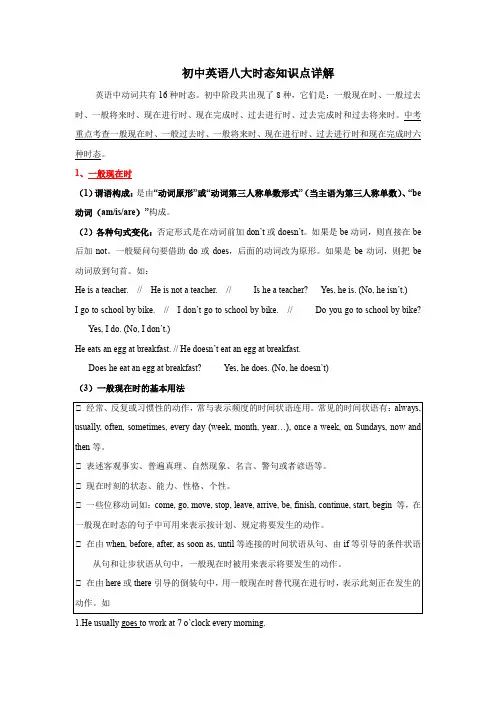
初中英语八大时态知识点详解英语中动词共有16种时态。
初中阶段共出现了8种,它们是:一般现在时、一般过去时、一般将来时、现在进行时、现在完成时、过去进行时、过去完成时和过去将来时。
中考重点考查一般现在时、一般过去时、一般将来时、现在进行时、过去进行时和现在完成时六种时态。
1、一般现在时(1)谓语构成:是由“动词原形”或“动词第三人称单数形式”(当主语为第三人称单数)、“be 动词(am/is/are)”构成。
(2)各种句式变化:否定形式是在动词前加don’t或doesn’t。
如果是be动词,则直接在be 后加not。
一般疑问句要借助do或does,后面的动词改为原形。
如果是be动词,则把be 动词放到句首。
如:He is a teacher. // He is not a teacher. // ---- Is he a teacher? --- Yes, he is. (No, he isn’t.)I go to school by bike. // I don’t go to school by bike. // ---- Do you go to school by bike? ---- Yes, I do. (No, I don’t.)He eats an egg at breakfast. // He doesn’t eat an egg at breakfast.---- Does he eat an egg at breakfast? ---- Yes, he does. (No, he doesn’t)(3)一般现在时的基本用法1.He usually goes to work at 7 o’clock every morning.2.Every dog has its day. 凡人皆有得意日。
3.Pride goes before a fall. 骄者必败。
4.The earth goes around the sun. 地球绕着太阳转。
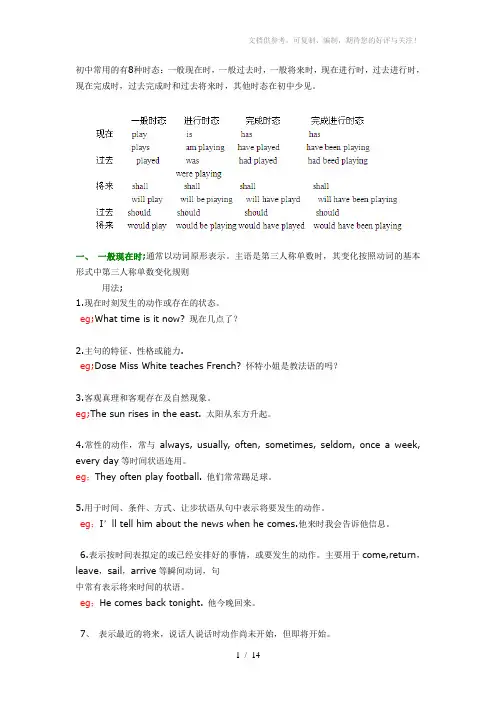
初中常用的有8种时态:一般现在时,一般过去时,一般将来时,现在进行时,过去进行时,现在完成时,过去完成时和过去将来时,其他时态在初中少见。
一、一般现在时;通常以动词原形表示。
主语是第三人称单数时,其变化按照动词的基本形式中第三人称单数变化规则用法;1.现在时刻发生的动作或存在的状态。
eg;What time is it now? 现在几点了?2.主句的特征、性格或能力.eg;Dose Miss White teaches French? 怀特小姐是教法语的吗?3.客观真理和客观存在及自然现象。
eg;The sun rises in the east. 太阳从东方升起。
4.常性的动作,常与always, usually, often, sometimes, seldom, once a week, every day等时间状语连用。
eg;They often play football. 他们常常踢足球。
5.用于时间、条件、方式、让步状语从句中表示将要发生的动作。
eg;I’ll tell him about the news when he comes.他来时我会告诉他信息。
6.表示按时间表拟定的或已经安排好的事情,或要发生的动作。
主要用于come,return,leave,sail,arrive等瞬间动词,句中常有表示将来时间的状语。
eg;He comes back tonight. 他今晚回来。
7、表示最近的将来,说话人说话时动作尚未开始,但即将开始。
eg;Now I go. 现在我走啦。
二、一般过去时;一般过去时是表示过去经常或偶然发生的动作或存在的状态的时态.用法;1、表示过去发生、完成的事或存在的状态,与表示过去时间的状语yesterday, last week, hours age, just now, in 1990等连用。
eg;What time is it now? 现在几点了?2.主句的特征、性格或能力.eg;Dose Miss White teaches French? 怀特小姐是教法语的吗?3. 表示过去经常或反复发生的动作,常与always, usually, often, sometimes, never等时间状语连用。
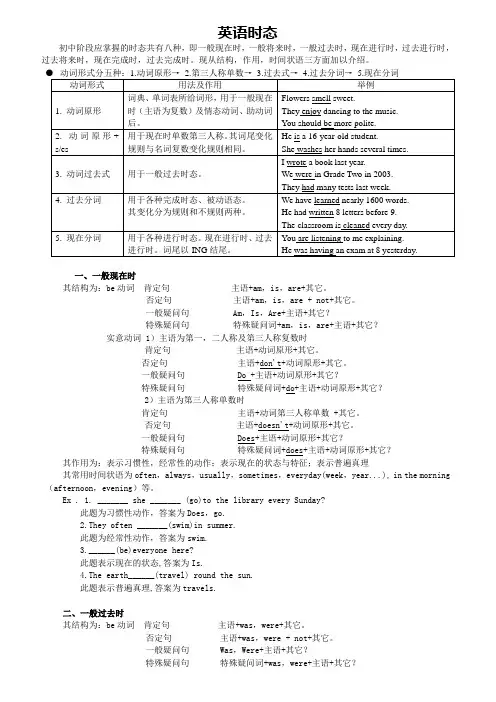
英语时态初中阶段应掌握的时态共有八种,即一般现在时,一般将来时,一般过去时,现在进行时,过去进行时,过去将来时,现在完成时,过去完成时。
现从结构,作用,时间状语三方面加以介绍。
一、一般现在时其结构为:be动词肯定句主语+am,is,are+其它。
否定句主语+am,is,are + not+其它。
一般疑问句 Am,Is,Are+主语+其它?特殊疑问句特殊疑问词+am,is,are+主语+其它?实意动词1)主语为第一,二人称及第三人称复数时肯定句主语+动词原形+其它。
否定句主语+don't+动词原形+其它。
一般疑问句 Do +主语+动词原形+其它?特殊疑问句特殊疑问词+do+主语+动词原形+其它?2)主语为第三人称单数时肯定句主语+动词第三人称单数 +其它。
否定句主语+doesn't+动词原形+其它。
一般疑问句 Does+主语+动词原形+其它?特殊疑问句特殊疑问词+does+主语+动词原形+其它?其作用为:表示习惯性,经常性的动作;表示现在的状态与特征;表示普遍真理其常用时间状语为often,always,usually,sometimes,everyday(week,year...), in the morning (afternoon,evening)等。
Ex . 1. _______ she _______ (go)to the library every Sunday?此题为习惯性动作,答案为Does,go.2.They often _______(swim)in summer.此题为经常性动作,答案为swim.3.______(be)everyone here?此题表示现在的状态,答案为Is.4.The earth______(travel) round the sun.此题表示普遍真理,答案为travels.二、一般过去时其结构为:be动词肯定句主语+was,were+其它。
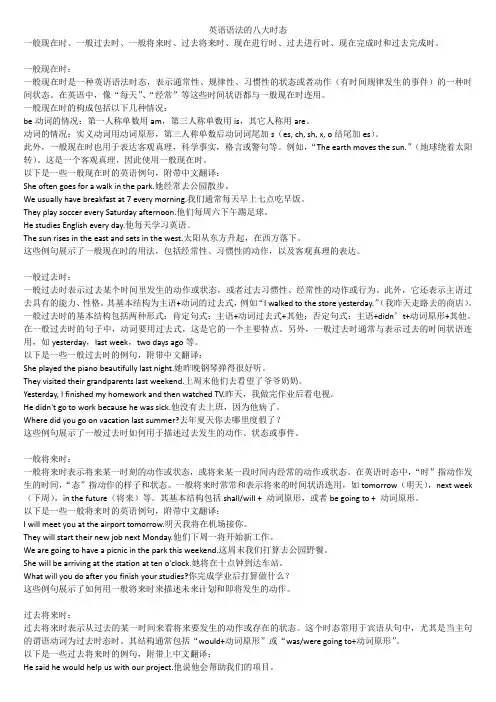
英语语法的八大时态一般现在时、一般过去时、一般将来时、过去将来时、现在进行时、过去进行时、现在完成时和过去完成时。
一般现在时:一般现在时是一种英语语法时态,表示通常性、规律性、习惯性的状态或者动作(有时间规律发生的事件)的一种时间状态。
在英语中,像“每天”、“经常”等这些时间状语都与一般现在时连用。
一般现在时的构成包括以下几种情况:be动词的情况:第一人称单数用am,第三人称单数用is,其它人称用are。
动词的情况:实义动词用动词原形,第三人称单数后动词词尾加s(es, ch, sh, x, o结尾加es)。
此外,一般现在时也用于表达客观真理,科学事实,格言或警句等。
例如,“The earth moves the sun.”(地球绕着太阳转)。
这是一个客观真理,因此使用一般现在时。
以下是一些一般现在时的英语例句,附带中文翻译:She often goes for a walk in the park.她经常去公园散步。
We usually have breakfast at 7 every morning.我们通常每天早上七点吃早饭。
They play soccer every Saturday afternoon.他们每周六下午踢足球。
He studies English every day.他每天学习英语。
The sun rises in the east and sets in the west.太阳从东方升起,在西方落下。
这些例句展示了一般现在时的用法,包括经常性、习惯性的动作,以及客观真理的表达。
一般过去时:一般过去时表示过去某个时间里发生的动作或状态,或者过去习惯性、经常性的动作或行为。
此外,它还表示主语过去具有的能力、性格。
其基本结构为主语+动词的过去式,例如“I walked to the store yesterday.”(我昨天走路去的商店)。
一般过去时的基本结构包括两种形式:肯定句式:主语+动词过去式+其他;否定句式:主语+didn’t+动词原形+其他。

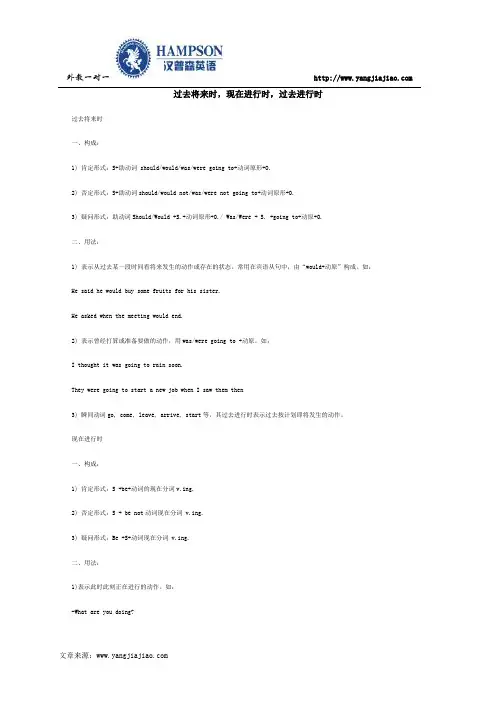
外教一对一过去将来时,现在进行时,过去进行时过去将来时一、构成:1) 肯定形式:S+助动词 should/would/was/were going to+动词原形+O.2) 否定形式:S+助动词should/would not/was/were not going to+动词原形+O.3) 疑问形式:助动词Should/Would +S.+动词原形+O./ Was/Were + S. +going to+动原+O.二、用法:1) 表示从过去某一段时间看将来发生的动作或存在的状态。
常用在宾语从句中,由“would+动原”构成。
如:He said he would buy some fruits for his sister.He asked when the meeting would end.2) 表示曾经打算或准备要做的动作,用was/were going to +动原。
如:I thought it was going to rain soon.They were going to start a new job when I saw them then3) 瞬间动词go, come, leave, arrive, start等,其过去进行时表示过去按计划即将发生的动作。
现在进行时一、构成:1) 肯定形式:S +be+动词的现在分词v.ing.2) 否定形式:S + be not动词现在分词 v.ing.3) 疑问形式:Be +S+动词现在分词 v.ing.二、用法:1)表示此时此刻正在进行的动作。
如:-What are you doing?外教一对一-I am reading English.2) 表示现阶段正在进行的动作或持续的状态。
如;They are studying hard this term.3) go, leave, arrive, start等动词用现在进行时表示将来。
常用于人,有“意图、打算、安排”含义,如:I am leaving Beijing this Sunday.Are you staying here till next week?4)当时间状语为now, these days等时或当句子中含有look, listen, can you see, can’t you see之类的暗示词,要使用现在进行时5)但要注意下列这些动词一般不用于现在进行时态的句子中。
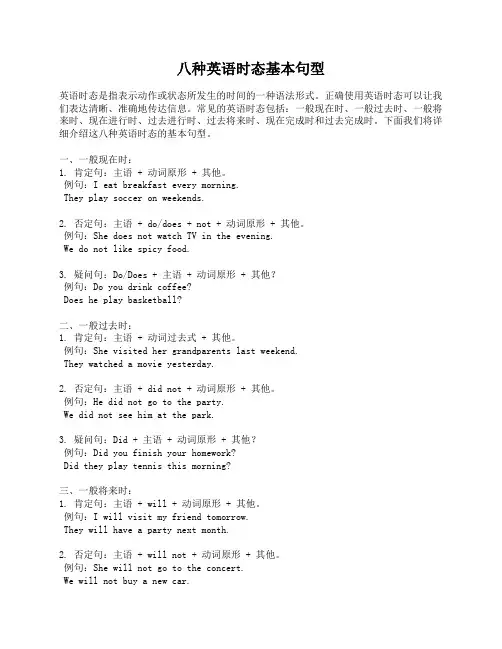
八种英语时态基本句型英语时态是指表示动作或状态所发生的时间的一种语法形式。
正确使用英语时态可以让我们表达清晰、准确地传达信息。
常见的英语时态包括:一般现在时、一般过去时、一般将来时、现在进行时、过去进行时、过去将来时、现在完成时和过去完成时。
下面我们将详细介绍这八种英语时态的基本句型。
一、一般现在时:1. 肯定句:主语 + 动词原形 + 其他。
例句:I eat breakfast every morning.They play soccer on weekends.2. 否定句:主语 + do/does + not + 动词原形 + 其他。
例句:She does not watch TV in the evening.We do not like spicy food.3. 疑问句:Do/Does + 主语 + 动词原形 + 其他?例句:Do you drink coffee?Does he play basketball?二、一般过去时:1. 肯定句:主语 + 动词过去式 + 其他。
例句:She visited her grandparents last weekend.They watched a movie yesterday.2. 否定句:主语 + did not + 动词原形 + 其他。
例句:He did not go to the party.We did not see him at the park.3. 疑问句:Did + 主语 + 动词原形 + 其他?例句:Did you finish your homework?Did they play tennis this morning?三、一般将来时:1. 肯定句:主语 + will + 动词原形 + 其他。
例句:I will visit my friend tomorrow.They will have a party next month.2. 否定句:主语 + will not + 动词原形 + 其他。
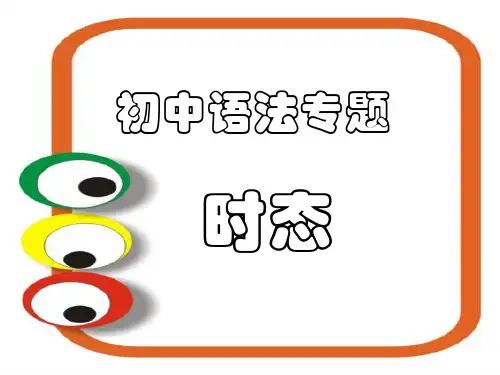
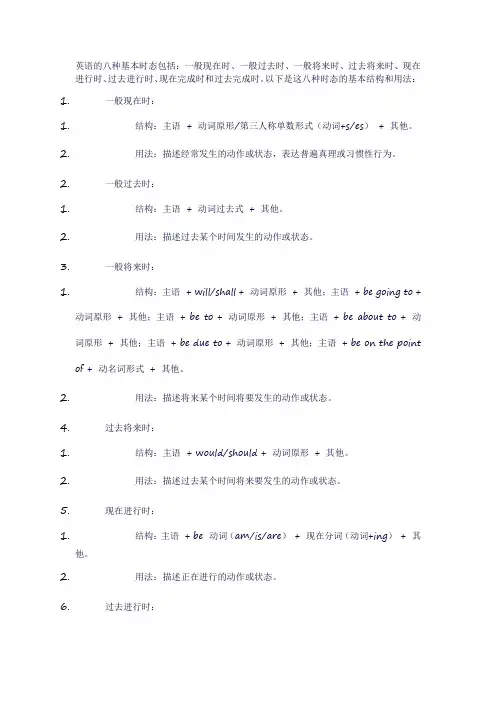
英语的八种基本时态包括:一般现在时、一般过去时、一般将来时、过去将来时、现在进行时、过去进行时、现在完成时和过去完成时。
以下是这八种时态的基本结构和用法:1.一般现在时:1.结构:主语+ 动词原形/第三人称单数形式(动词+s/es)+ 其他。
2.用法:描述经常发生的动作或状态,表达普遍真理或习惯性行为。
2.一般过去时:1.结构:主语+ 动词过去式+ 其他。
2.用法:描述过去某个时间发生的动作或状态。
3.一般将来时:1.结构:主语+ will/shall + 动词原形+ 其他;主语+ be going to +动词原形+ 其他;主语+ be to + 动词原形+ 其他;主语+ be about to + 动词原形+ 其他;主语+ be due to + 动词原形+ 其他;主语+ be on the point of + 动名词形式+ 其他。
2.用法:描述将来某个时间将要发生的动作或状态。
4.过去将来时:1.结构:主语+ would/should + 动词原形+ 其他。
2.用法:描述过去某个时间将来要发生的动作或状态。
5.现在进行时:1.结构:主语+ be 动词(am/is/are)+ 现在分词(动词+ing)+ 其他。
2.用法:描述正在进行的动作或状态。
6.过去进行时:1.结构:主语+ be 动词的过去式(was/were)+ 现在分词(动词+ing)+ 其他。
2.用法:描述过去某个时间点正在进行的动作或状态。
7.现在完成时:1.结构:主语+ have/has + 过去分词(动词+ed)+ 其他。
2.用法:描述过去发生的动作对现在造成的影响或结果,或者表示从过去某一时间开始一直持续到现在的情况。
8.过去完成时:1.结构:主语+ had + 过去分词(动词+ed)+ 其他。
2.用法:描述过去某个时间点之前已经完成的动作或状态,或者表示一个过去的动作在另一个过去的动作之前发生。
请注意,以上列出的时态结构和用法是基本的概述,实际使用中可能因语境和习惯而有所不同。
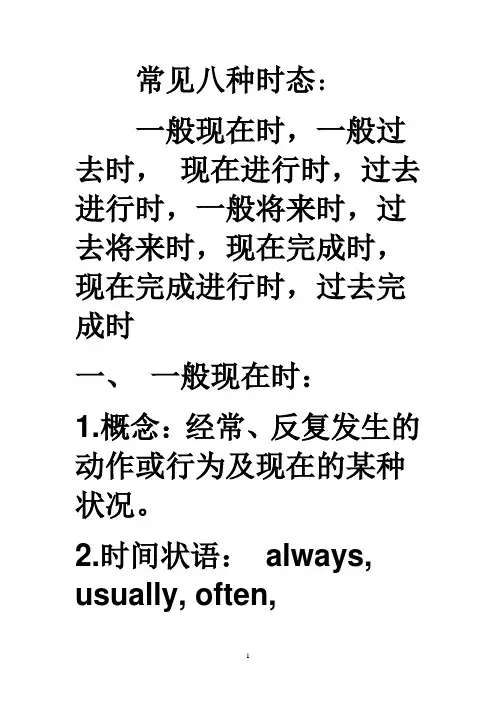
常见八种时态:一般现在时,一般过去时,现在进行时,过去进行时,一般将来时,过去将来时,现在完成时,现在完成进行时,过去完成时一、一般现在时:1.概念:经常、反复发生的动作或行为及现在的某种状况。
2.时间状语:always, usually, often,sometimes, every week (day, year, month…), once a week, on Sundays,3.基本结构:动词原形(如主语为第三人称单数,动词上要改为第三人称单数形式)4.否定形式:am/is/are+not;此时态的谓语动词若为行为动词,则在其前加don't,如主语为第三人称单数,则用doesn't,同时还原行为动词。
5.一般疑问句:把be动词放于句首;用助动词do提问,如主语为第三人称单数,则用does,同时,还原行为动词。
6.例句:. It seldom snows here.He is always ready to help others.Action speaks louder than words.二、一般过去时:1.概念:过去某个时间里发生的动作或状态;过去习惯性、经常性的动作、行为。
2.时间状语:ago, yesterday, the day before yesterday, last week,last(year, night, month…), in 1989, just now, at the age of 5, one day, long long ago, once upon a time(从前), etc.3.基本结构:be动词;行为动词的过去式4.否定形式:was/were+not;在行为动词前加didn't,同时还原行为动词。
5.一般疑问句:was或were放于句首;用助动词do的过去式did 提问,同时还原行为动词。
6.例句:She often came to help us in those days.I didn't know you were so busy.三、现在进行时:1.概念:表示现阶段或说话时正在进行的动作及行为。
一、一般现在时:概念:经常、反复发生的动作或行为及现在的某种状况。
时间状语:always, usually, often, sometimes, every week (day, year, month…), once a week, etc.基本结构:①be动词;②行为动词否定形式:①am/is/are+not;②此时态的谓语动词若为行为动词,则在其前加don't,如主语为第三人称单数,则用doesn't,同时还原行为动词。
一般疑问句:①把be动词放于句首;②用助动词do提问,如主语为第三人称单数,则用does,同时,还原行为动词。
一般现在时主要由动词原形表示,但第三人称单数后要加词尾-s,另外be 和have 要根据人称的变化使用特殊的形式。
一般现在时主要表示经常性的动作或存在的状态,还可用来表示普遍真理。
The Yangtze rises in Qinghai. 长江发源于青海。
Actions speak louder than words. 行动胜于言辞。
We have friends all over the world. 我们的朋友遍天下。
二、一般过去时:概念:过去某个时间里发生的动作或状态;过去习惯性、经常性的动作、行为。
时间状语:ago, yesterday, the day before yesterday, last week(year, night, month…), in 1989, just now, at the age of 5, one day, long long ago, once upon a time, etc.基本结构:①be动词;②行为动词否定形式:①was/were+not;②在行为动词前加didn't,同时还原行为动词。
一般疑问句:①was或were放于句首;②用助动词do的过去式did 提问,同时还原行为动词。
一般过去时由动词过去式表示,动词be 根据人称有was和were两个词形,规则动词在词尾加-d-或ed;其他动词参阅不规则动词变化表, 该时态主要表示过去某时发生的动作或情况。
英语最常用的8种时态英语最常用的8种时态:一般现在时、一般现过去时、现在进行时、过去进行时、现在完成时、过去完成时、—般将来时、过去将来时。
1、一般现在时一般现在时,是一种英语语法形式。
表示通常性、规律性、习惯性、真理性(即事实)的动作或状态,或者动作有时间规律发生的事件的一种时间状态。
在英语语法中,“时“指动作发生的时间,”态“指动作的样子和状态。
2、一般现过去时一般过去将来时表示从过去的某一时间来看将来要发生的动作或呈现的状态。
在英语时态中,“时“指动作发生的时间,”态“指动作的样子和状态。
一般过去将来时的出发点是过去,即从过去某一时刻看以后要发生的动作或状态。
3、现在进行时现在进行时,专业术语,是英语的一种时态,表示现在进行的动作或存在的状态。
在英语时态中,“时“指动作发生的时间,”态“指动作的样子和状态。
现在进行时表示动作发生的时间是“现在”,动作目前的状态是“正在进行中”。
4、过去进行时过去进行时,表示过去在某一时间段或某一段时间内正在发生或进行的动作或状态。
在英语时态中,“时“指动作发生的时间,”态“指动作的样子和状态。
5、现在完成时由“have/has+过去分词”构成,主要有两个含义:表示动作发生在过去,但与现在的情况有联系,有时无时间状语,有时和一些表示不确定的过去时间状语连用,如:many times,just,yet,ever,never,already,before,so far, by now等连用。
6、过去完成时过去完成时:表示过去某一时间或动作以前已经发生或完成了的动作,对过去的某一点造成的某种影响或是结果,用来指在另一个过去行动之前就已经完成了的事件。
在英语时态中,“时“指动作发生的时间,”态“指动作的样子和状态。
它表示动作发生的时间是“过去的过去”,侧重事情的结果。
7、—般将来时一般将来时表示将来某一时段的动作或状态,或将来某一段时间内经常的动作或状态。
在英语时态中,“时“指动作发生的时间,”态“指动作的样子和状态。
16种英语时态的讲解英语动词有十六种时态,常用的有八种:一般现在时、一般过去时、一般将来时、现在进行时、过去进行时、过去将来时、现在完成时和过去完成时。
一、现在:现在一般时、现在完成时、现在进行时、现在完成进行时..............................1-1 现在一般时1.表示现在的状态:e.g. He’s twelve.She’s at work.2.表经常或习惯性的动作:e.g. I get up at 6:30 every day.He reads English every morning.3.表主语具备的性格和能力等:e.g. She likes noodles.They speak French.4.普遍真理和自然规律:e.g. Two plus four is six.The moon goes around the earth.一般动词:主语是第一人称单复数时,没有变化;主语是第三人称时,动词+s,以sh /ch/ s/x /z/ o 加es,以y结尾的,前面是元音字母的直接加es,前面是辅音字母的,把y改i加es。
1-2 现在完成时现在完成时构成: have/has + 动词的过去分词1.定义:现在完成时表示到目前为止已经完成,并对现在留下某种后果和影响的动作。
1.表示过去发生的某一动作对现在造成的影响或结果,常与一些时间状语2.表示过去发生的动作或存在的状态,一直持续到现在,也许还将继续下去,可以和表示从过去某一时刻延续到现在的一段时间的状语连用如:already已经,早以, yet仍然,还, ever曾经, never从不;决不,从未,从来没有, just 刚刚,仅仅, before在···之前, once一次,曾经,twice两次,两倍,等连用,也可以和包括现在在内的时间状语,如these days,today,this year,so far(目前,到目前为止)等连用.即for +时间段,since(自从)+时间点/从句, in the last ten years等,谓语只可用延续性动词.2. has/have been to 去过某地表示某人的一种经历,可与once,twice,already,ever,never,等连用。
初中英语时态8种基本时态结构八种基本时态时间是人类的共同认知,学习语言的过程也不可避免的牵涉到时态的描述。
在初中英语中,我们主要掌握八种基本时态结构,即一般现在时、一般过去时、现在进行时、过去进行时、现在完成时、过去完成时、将来时、过去将来时。
一般现在时表示经常性或习惯性动作,常用于描述客观现存的事实,表达真理、命题、法则和科学知识。
this is He usually goes to school by bike.一般过去时用来叙述过去发生的事,常与一般过去时助动词did一起使用,表示已完成的动作。
例如:I did my homework yesterday.现在进行时描述正在进行的动作,可以用来表示临时的正在发生的动作和经常性的正在发生的动作,在其句子中要用现在进行时的动词,以及一般助动词am、is、are等。
例如:She is watching TV.过去进行时也描写进行的动作,但指发生在过去的动作,句中要用过去进行时的动词,助动词时was或were.例如:I was doing my homework when she came.现在完成时表达过去发生的动作,它的过去的动作可能发生在现在仍有影响的现象之前,句子中用现在完成时的动词,与have/has 和过去分词一起形成结构。
例如:I have finished my homework already.过去完成时是表达某个动作在更远的过去发生,在句子中要用过去完成时动词,用had连接had 和过去分词构成。
例如:He had finished his homework before dinner.将来时指将要发生的事情或正在进行的事情,句子中用将来时的动词,两个助动词will和shall。
例如:He will do his homework in the evening.过去将来时描写在过去的一定时刻,某个将来时间的某个动作,句子中用一般将来时的动词,两个助动词would和should来构成结构。
初中英语八种时态归纳
初中英语八种时态包括:一般现在时、一般过去时、现在进行时、过去进行时、现在完成时、过去完成时、一般将来时和过去将来时。
1. 一般现在时:表示通常性、规律性、习惯性的状态或者动作(有时间规律发生的时间状语)。
动词用原形。
2. 一般过去时:表示过去某个时间里发生的动作或状态;或过去习惯性的动作。
动词过去式发生变化。
3. 现在进行时:表示现在进行的动作或存在的状态。
现在进行时的基本结构:主语+系动词+表语+其他。
4. 过去进行时:表示过去某段时间或某一时刻正在发生或进行的动作。
其结构由连接词was/were+动词的现在分词构成。
5. 现在完成时:表示过去发生的动作对现在造成的影响或结果。
动词结构是“have+过去分词”。
6. 过去完成时:表示在过去某一时间或动作之前已经发生或完成的动作。
动词结构是“had+过去分词”。
7. 一般将来时:表示将来发生的动作或存在的状态,也表示将来要实行的计划或打算。
动词结构是“will+动词原形”或“be going to+动词原形”。
8. 过去将来时:表示在过去某个时间看来将要发生的动作或存在的状态,及过去的打算或推测。
动词结构是“would+动词原形”或“was/were going to+动词原形”。
以上是初中英语八种时态的归纳,记住口诀“4个1,24678”,即每一种时态都有一种标志性的结构,如一般现在时的标志性结构是主语+系动词+表语,一般过去时的标志性结构是主语+动词的过去式等。
英语八大时态标志词及结构表篇一:英语八大时态标志词及结构表正文:英语中存在八大时态,分别是:过去时、现在时、将来时、过去将来时、现在进行时、将来进行时、过去进行时、现在完成时和未来完成时。
这些时态的不同表达方式和用法,对于英语写作和口语表达都是非常重要的。
本文将介绍这些时态的标志词和结构表,帮助学习者更好地理解和掌握这些时态。
1. 过去时过去时通常用“态”或“ed”表示,表示动作或状态发生在过去。
标志词包括:- was(过去分词):表示动作或状态发生在过去某个时间。
- are(过去分词):表示动作或状态发生在过去。
- was/are(过去分词):表示动作或状态发生在过去的某个时刻。
结构表:| 主语 | 谓语动词 | 时态标志词 || --- | --- | --- || I | I was | was/are || you | you are | are || he/she/it | he/she/it was | was/are || we | we are | are || they | they were | were/are |2. 现在时现在时通常用“态”或“ing”表示,表示动作或状态现在正在进行。
标志词包括:- am/is(现在分词):表示动作或状态现在正在进行。
- are(现在分词):表示动作或状态现在正在进行。
- was/are(现在分词):表示动作或状态现在正在进行。
结构表:| 主语 | 谓语动词 | 时态标志词 || --- | --- | --- || I | I am | am/is || you | you are | are || he/she/it | he/she/it is | is/are || we | we are | are || they | they are | are |3. 将来时将来时通常用“态”或“ing”表示,表示动作或状态将来会发生。
标志词包括:- will(将来分词):表示动作或状态将来会发生。
现在进行时-过去进行时和过去将来时一、现在进行时(一)结构由Be(am/is/are) +动词—ing 构成。
(二)用法1、表示说话时刻正在进行的动作及行为,或者包括说话时刻在内的一段时间正在进行的动作。
常用时间状语及标志词:now( at the moment ) , listen , look , this week , this evening , these days 等。
Listen , Someone is playing the piano in the next room .2、表示一种渐进的过程。
My younger brother is becoming more and more interested in English .3、与always , all the time , forever等连用,表示说话人某种强烈的情感,如:赞许、批评;喜欢、厌恶等。
例如:He is always thinking of others , not of himself . (表示赞许)他总是为他人着想,而不为自己。
She is often doing well at school. (表示满意)她在学校学习挺不错的。
Are you feeling better today? (表示亲切)你今天觉得好一些吗?One of my roommates is constantly leaving things about.(表示不满)我的一个室友老是乱扔东西。
Some sellers are often knocking at our door and promoting their products to us .(表示不喜欢)有些推销员老是敲我家的门,向我们推销他们的产品。
4、表示移位的动词,如go,come,leave,start,arrive等,其现在进行时可表将来。
She is leaving for Beijing next weak .My friend is coming for dinner .(三)句型1、肯定句:主语+ be(am/is/are) +动词—ing +其他。
I am studying now .2、否定句:主语+ be +not+动词—ing +其他。
I am not studying now .3、一般疑问句:Be+主语+动词—ing +其他?Is she studying now ? Yes ,she is ./No,she isn’t .4、特殊疑问句:特殊疑问词+ Be+主语+动词—ing +其他?What are you doing now ?(四)动词的现在分词形式构成的几种方法:1、一般在动词原形结尾直接加-ing 。
read-reading ,go-going ,visit-visiting2、以不发音字母e结尾的动词,去e再加-ing。
live-living, write-writing,make-making,take-taking3、以重读闭音节结尾且末尾只有一个辅音字母的词,双写这个字母再加-ing 。
sit-sitting,begin-beginning,get-getting,run-running,put-putting4、少数几个以ie结尾的动词,变ie为y再加-ing。
die-dying, lie-lying, tie-tyingh )clothes? Yes ,she is现在进行时态练习题一、写出下列动词的现在分词形式:wait live growplay have sleepfly sing comego read getrain draw put二、根据句意,用所给动词的适当形式填空:1. Listen, Mr. Wu on the phone (talk).2. I soccer now. I’m walking (not play)3. ---Is your father at home?---Yes, he is .He a TV show. (watch)4. They to go to the shop now. (want)5. --- you for your friends? (wait)---No, I’m not.6. Steve is very busy. He a letter (write)7. Don’t speak! My father(sleep).8. It’s twelve o’clock. The students(have) lunch.9. Don’t go out! It outside. (rain)10. ---Why are you standing here , Dave?---I for Scott. (wait)11. The boys (help) their mother in the kitchen now.12. The sky is blue and the sun (shine).13. What those people (do) now? They (look)at the pictures.14. Look, Sam (dig) in the garden.15. Are you (think) about your English lesson?16. The children (listen) to the music.17. he (run) on the playground?18. Jim and Pat (read) right now?19. What are they doing? They (swim) in the sea?20. What are you doing? I (play) the piano.三、按要求改写句子。
1.The children are making a model. (否定句)2. Tim is eating an apple. (一般疑问句)3. Are you doing your homework now? (作肯定和否定回答)4. They are studying at home. (at school) (改为选择疑问句)they at home at school?5. Miss Wang is sitting in a sofa. (对划线部分提问)6. They are working in a factory these days.7. She is learning the piano this year. (用learning the violin 改为选择疑问句)8. Helen’s father is cleaning his car. (对划线部分提问)9. I am reading English in the garden. (对划线部分提问)10. Tom and Bob are listening to the radio. (对划线部分提问)11. I am wanting to buy a hot dog for my lunch. (改错)二、过去进行时(一)结构由was/were+动词-ing构成。
(二)用法表示过去某一时刻或某一段时间正在进行或发生的动作。
动作发生的特指时间常用一个短语或时间状语从句来表明,如:at this time yesterday,at 7:00 yesterday ,last night ,from seven to nine ,at that time以when或while引导的时间状语从句等。
My family were watching TV at this time yesterday .注意:(1)以when引导的时间状语从句中,从句动作,主句用过去进行时,表示一个动作发生时,另一个动作正在进行。
When he called me , I was having dinner .(2)以while引导的时间状语从句中,从句与主句的动作在过去某一时刻同时进行,while常译为“当……的时候,同时”。
Tom was doing his homework while hie sister was watching TV .过去进行时练习题一、用所给动词的适当形式填空1. I______ (play) computer games at ten last night.2. Jim’s family ______ (have) supper when I came in.3. It _______ (rain) hard at this time yesterday.4. What ____you ____ (do) while I____ (make) a model plane.5. He ___just _____ (leave) when the telephone rang.6. We ________ (have) a P.E class at four yesterday.7. They __________ (read) at eight yesterday evening.8. I ________ (do) my homework at that time when you called me.9._____ you _______ (sweep) the floor while your mother _________ (cook)?10. We (not talk) with each other yesterday morning.11. What ___ you _____(do) at eight last night?12. I (work) from six to eight every evening two years ago.13. She (walk) home when she _____(see) her old friend.14. I (read) a novel when I ______(have) a sudden idea.15. Colin _________ (play) football with them at seven yesterday evening.16.____ they ____ (help) you with your English from 8 to 10 last night?17.We (listen) to the music while they (dance) .18. My son (brush) his teeth when I _______(call) him.二、按要求改写下列句子1. It was raining hard when we left the cinema. (否定句)2. We were watching TV this time yesterday. (一般疑问句)3. Were you talking on the phone when the doorbell rang? (作肯定回答和否定回答)4.She was reading at nine o’clock last night. (用watching TV改为选择疑问句)5. They were working in a factory those days. (对划线部分提问)6. They were having a volleyball match this time last week. (对划线部分提问)7. The policemen were running after a thief at 8 last night. (对划线部分提问)8. The teacher was talking with a naughty boy when the telephone rang. (对划线部分提问)三、选择题1.I ______ cooked a meal when you _____ me.a. cooked, were ringingb. was cooking, rangc. was cooking, were ringingd. cooked, rang2.He said he _____ to draw a plane on the blackboard at that time.a. triesb. triedc. was tryingd. will try3.While she ______ TV, she ______ a sound outside the room.a. was watching, was hearingb. watched, was hearingc. watched, heardd. was watching, heard4.They _____ a football game from 7 to 9 last night.a. were watchingb. watchc. watchedd. are watching5.What book ____ you ______ when I ____ you at four yesterday afternoon?a. did, read, was seeingb. did, read, sawc. were, reading, sawd. were, reading, was seeing6.It was Friday evening. Mr and Mrs. Green _____ ready to fly to England.a. are gettingb. getc. were gettingd. got7.Lei Feng _____ always _____ of others when he ______ in the army.a. is, thinking, wasb. was, thinking, isc. did, think, isd. was, thinking, was8.A girl ______ my pen fall off the table when she _____ me.a. saw, passedb. was seeing, passedc. was seeing, passedd. was seeing, was passing9.We ____ for tom at ten last Sunday. He often kept us ______.a. were waiting, waitingb. were waiting, waitc. waited, waitingd. waited, wait10.He ____ his father on the farm the whole afternoon last Saturday.a. helpsb. would helpc. was helpingd. is helping11.While mother _______ some washing, I _____ a kite for Kate.a. did, madeb. was doing, madec. was doing, was makingd. did, was making12."_______ you angry then?" "they ______ too much noise."a. are, were makingb. were, were makingc. are, maded. were, made13.He ____ some cooking at that time, so _____ mea. did, heardb. did, didn't hearc. was doing, heardd. was doing, didn't hear14.This time yesterday jack _____ his bike. He _____ TVa. repaired, didn't watchb. was repairing, watchedc. repaired, watchedd. was repairing, wasn't watching15.His parents wanted to know how he _____ on with his new classmates.a. was gettingb. getsc. is gettingd. will get三、过去将来时表示过去的某时以后将要发生的动作。